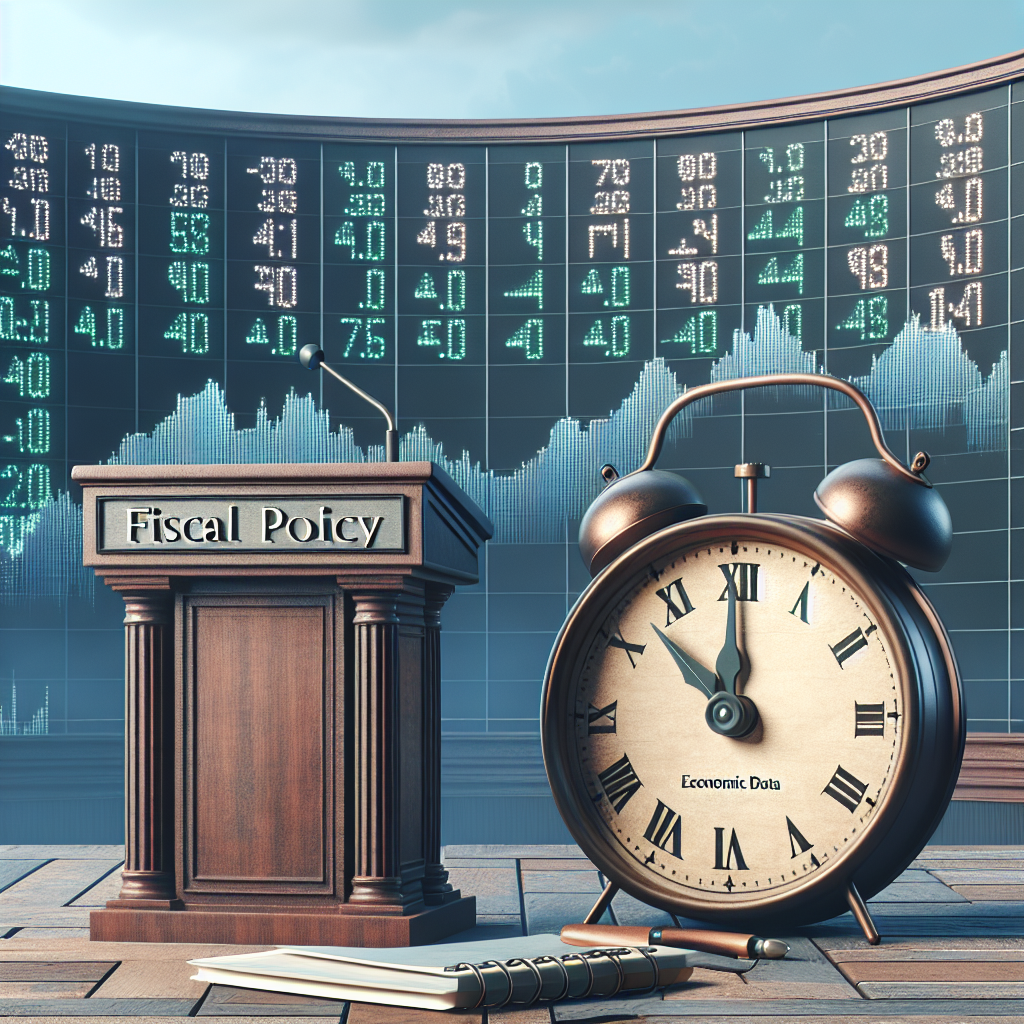“Steady Futures: Markets Poised for Powell’s Insights and Economic Revelations”
Introduction
Futures markets remained steady as investors exercised caution ahead of key economic data releases and a highly anticipated speech by Federal Reserve Chair Jerome Powell. Market participants are closely monitoring these developments for insights into the future trajectory of monetary policy and economic health. The upcoming data, which includes reports on employment, inflation, and consumer spending, is expected to provide critical signals on the strength of the economy and potential policy adjustments. Powell’s speech is particularly significant as it may offer further clarity on the Fed’s stance regarding interest rates and inflation management. As a result, traders are maintaining a watchful stance, balancing optimism with prudence in anticipation of potential market-moving information.
Understanding Futures Markets: Key Indicators to Watch
Futures markets play a crucial role in the global financial ecosystem, serving as a barometer for investor sentiment and economic expectations. As investors and analysts keenly await upcoming economic data and a speech by Federal Reserve Chair Jerome Powell, understanding the key indicators within futures markets becomes essential. These indicators not only provide insights into market trends but also help in forecasting potential economic shifts.
To begin with, futures contracts are agreements to buy or sell an asset at a predetermined price at a specified time in the future. They are widely used by investors to hedge against risks or speculate on price movements. The prices of these contracts are influenced by a myriad of factors, including economic data releases, geopolitical events, and central bank policies. As such, they offer a glimpse into market expectations and potential future movements.
One of the primary indicators to watch in futures markets is the interest rate futures. These contracts are sensitive to changes in monetary policy and are often used to gauge market expectations regarding interest rate adjustments. For instance, if the market anticipates a rate hike by the Federal Reserve, interest rate futures may reflect this by pricing in higher rates. Consequently, investors closely monitor these futures to align their strategies with anticipated policy shifts.
In addition to interest rate futures, commodity futures also serve as vital indicators. Commodities such as oil, gold, and agricultural products are integral to the global economy, and their futures prices can signal changes in supply and demand dynamics. For example, a rise in oil futures might indicate expectations of increased demand or potential supply disruptions. Similarly, fluctuations in gold futures can reflect investor sentiment towards risk, as gold is often considered a safe-haven asset during times of uncertainty.
Equity index futures, which track major stock indices like the S&P 500 or the Dow Jones Industrial Average, are another critical component of futures markets. These futures provide insights into investor sentiment towards the broader equity market. A steady or rising trend in equity index futures may suggest optimism about corporate earnings or economic growth, while a decline could indicate concerns about potential downturns or geopolitical tensions.
As markets await the release of economic data and Powell’s speech, the interplay between these futures indicators becomes even more pronounced. Economic data, such as employment figures, inflation rates, and GDP growth, can significantly impact futures prices. Positive data may bolster confidence and drive futures higher, while disappointing figures could lead to a pullback. Similarly, Powell’s speech is likely to be scrutinized for any hints regarding future monetary policy, which could influence interest rate futures and, by extension, other market segments.
In conclusion, futures markets offer a wealth of information through various indicators that reflect investor sentiment and economic expectations. By closely monitoring interest rate futures, commodity futures, and equity index futures, investors can gain valuable insights into potential market movements. As the financial world eagerly anticipates new economic data and guidance from the Federal Reserve, these indicators will undoubtedly play a pivotal role in shaping market dynamics and informing investment decisions. Understanding these key indicators is essential for navigating the complexities of futures markets and making informed financial choices.
The Role of Economic Data in Shaping Market Trends
In the intricate world of financial markets, economic data serves as a crucial compass, guiding investors and policymakers alike through the often turbulent waters of global finance. As futures remain steady, market participants are keenly awaiting the release of key economic data and a speech by Federal Reserve Chair Jerome Powell, both of which are anticipated to provide further insights into the current economic landscape. Understanding the role of economic data in shaping market trends is essential for comprehending the broader implications of these events.
Economic data encompasses a wide array of indicators, including employment figures, inflation rates, gross domestic product (GDP) growth, and consumer confidence indices, among others. These indicators collectively paint a picture of the economic health of a nation and, by extension, influence market sentiment. For instance, robust employment data can signal a thriving economy, potentially leading to increased consumer spending and business investment. Conversely, weak employment figures might suggest economic stagnation, prompting concerns about future growth prospects.
As investors await the latest economic data, they are particularly focused on inflation metrics, given their significant impact on monetary policy decisions. Inflation, the rate at which the general level of prices for goods and services rises, erodes purchasing power and can lead to higher interest rates as central banks attempt to curb its effects. In this context, the Federal Reserve’s approach to managing inflation is of paramount importance. Market participants closely scrutinize inflation data to gauge the likelihood of interest rate adjustments, which in turn affect borrowing costs, consumer spending, and ultimately, corporate profits.
In addition to economic data, speeches by influential figures such as Federal Reserve Chair Jerome Powell hold considerable sway over market trends. Powell’s remarks are meticulously analyzed for any hints regarding the future direction of monetary policy. His insights into the Fed’s assessment of the economy, inflationary pressures, and potential policy shifts can significantly influence investor sentiment and market movements. As such, Powell’s upcoming speech is eagerly anticipated, with market participants hoping for clarity on the Fed’s stance amid ongoing economic uncertainties.
The interplay between economic data and market trends is further complicated by external factors, such as geopolitical tensions, technological advancements, and global supply chain disruptions. These elements can exacerbate or mitigate the effects of economic indicators, adding layers of complexity to market analysis. For example, geopolitical tensions may lead to fluctuations in commodity prices, which can, in turn, impact inflation and economic growth. Similarly, technological advancements can drive productivity gains, influencing GDP growth and employment trends.
In conclusion, economic data plays a pivotal role in shaping market trends, providing valuable insights into the health and trajectory of the economy. As futures remain steady, the anticipation surrounding the release of key economic data and Jerome Powell’s speech underscores the importance of these elements in guiding market participants’ decisions. By closely monitoring economic indicators and analyzing the implications of policy statements, investors can better navigate the complexities of the financial landscape. Ultimately, understanding the intricate relationship between economic data and market trends is essential for making informed investment decisions and anticipating future market movements.
Analyzing Jerome Powell’s Impact on Financial Markets
As financial markets brace for a series of pivotal economic data releases, investors are keenly focused on the forthcoming speech by Federal Reserve Chair Jerome Powell. His words are often scrutinized for insights into the central bank’s monetary policy direction, which can significantly influence market dynamics. The anticipation surrounding Powell’s address underscores the critical role he plays in shaping investor sentiment and guiding economic expectations.
In recent years, Powell’s speeches have become a barometer for market participants, offering clues about the Federal Reserve’s stance on interest rates, inflation, and economic growth. His ability to communicate complex economic concepts in a clear and measured manner has earned him a reputation as a steady hand in turbulent times. As such, any indication of a shift in policy or economic outlook can lead to swift reactions across global financial markets.
The current market environment is characterized by a delicate balance between optimism and caution. On one hand, there are signs of economic recovery, bolstered by robust corporate earnings and improving labor market conditions. On the other hand, concerns about inflationary pressures and geopolitical uncertainties continue to weigh on investor confidence. In this context, Powell’s speech is expected to provide much-needed clarity on the Federal Reserve’s approach to navigating these challenges.
Moreover, the timing of Powell’s address is particularly significant, as it coincides with the release of key economic indicators. These data points, including employment figures and inflation metrics, will offer a snapshot of the economy’s health and inform the central bank’s policy decisions. Investors will be closely monitoring how Powell interprets these figures and whether he signals any adjustments to the current monetary policy framework.
In addition to domestic considerations, Powell’s speech will also be viewed through an international lens. Global markets are interconnected, and the Federal Reserve’s policies can have far-reaching implications beyond U.S. borders. For instance, changes in interest rates can affect currency valuations, capital flows, and trade dynamics. As such, international investors will be attuned to Powell’s remarks, seeking to gauge the potential impact on their own economies and investment strategies.
Furthermore, Powell’s communication style plays a crucial role in managing market expectations. His emphasis on transparency and forward guidance helps to reduce uncertainty and foster stability. By clearly articulating the Federal Reserve’s objectives and the rationale behind its decisions, Powell aims to build trust and confidence among market participants. This approach is particularly important in times of economic transition, where clear communication can mitigate the risk of market volatility.
As markets await Powell’s speech, it is important to recognize the broader context in which his remarks will be delivered. The global economy is at a crossroads, with policymakers grappling with the dual challenges of sustaining growth and controlling inflation. In this environment, Powell’s insights will be invaluable in shaping the narrative around economic recovery and the path forward for monetary policy.
In conclusion, Jerome Powell’s impact on financial markets cannot be overstated. His speeches serve as a critical touchpoint for investors, providing guidance and reassurance in an ever-evolving economic landscape. As markets remain steady in anticipation of his address, the focus will be on deciphering his message and understanding its implications for the future of monetary policy and global economic stability.
How Investors Prepare for Major Economic Announcements

As investors navigate the complex landscape of financial markets, the anticipation of major economic announcements often brings a mix of anxiety and opportunity. The steadying of futures ahead of such events, like the release of key economic data or a speech by Federal Reserve Chair Jerome Powell, reflects a period of cautious optimism and strategic positioning. Understanding how investors prepare for these pivotal moments can provide valuable insights into market dynamics and the decision-making processes that underpin investment strategies.
In the days leading up to significant economic announcements, investors typically engage in a thorough analysis of available data and market trends. This involves scrutinizing recent economic indicators, such as employment figures, inflation rates, and consumer spending patterns, to gauge the current health of the economy. By doing so, investors aim to predict the potential impact of upcoming announcements on market conditions. For instance, if recent data suggests a robust economy, investors might anticipate a more hawkish stance from the Federal Reserve, potentially leading to higher interest rates. Conversely, signs of economic slowdown could prompt expectations of a dovish approach, with interest rates remaining unchanged or even reduced.
Moreover, investors often turn to historical data to understand how markets have reacted to similar announcements in the past. This historical perspective can offer valuable clues about potential market movements, helping investors to formulate strategies that align with their risk tolerance and investment goals. For example, if past speeches by Powell have led to increased market volatility, investors might choose to adopt a more conservative approach, reducing exposure to high-risk assets in favor of safer investments like bonds or gold.
In addition to data analysis, investors also pay close attention to market sentiment, which can be influenced by a variety of factors, including geopolitical events, corporate earnings reports, and global economic trends. By monitoring news outlets, financial reports, and social media platforms, investors can gauge the prevailing mood of the market and adjust their strategies accordingly. A positive sentiment might encourage more aggressive investment strategies, while a negative outlook could lead to a more cautious approach.
As the time for the announcement draws near, investors often engage in portfolio rebalancing to ensure that their asset allocation aligns with their expectations for market movements. This might involve increasing or decreasing exposure to certain sectors, such as technology or healthcare, based on anticipated economic trends. Additionally, investors might employ hedging strategies, such as options or futures contracts, to protect their portfolios against potential losses.
Finally, communication plays a crucial role in how investors prepare for major economic announcements. Financial advisors, analysts, and institutional investors often engage in discussions and debates, sharing insights and predictions that can influence individual investment decisions. By participating in these conversations, investors can gain a broader understanding of market expectations and refine their strategies accordingly.
In conclusion, the steadying of futures as markets await economic data and Powell’s speech underscores the intricate preparations undertaken by investors. Through a combination of data analysis, historical perspective, sentiment monitoring, portfolio rebalancing, and communication, investors strive to position themselves advantageously in anticipation of market shifts. This comprehensive approach not only helps mitigate risks but also enhances the potential for capitalizing on opportunities that arise from major economic announcements. As such, understanding these preparatory steps is essential for anyone looking to navigate the ever-evolving world of financial markets.
The Relationship Between Futures and Economic Forecasts
Futures markets play a crucial role in the financial ecosystem, serving as a barometer for investor sentiment and expectations about future economic conditions. As investors and analysts keenly await the release of key economic data and a speech by Federal Reserve Chair Jerome Powell, the futures markets remain steady, reflecting a cautious optimism tempered by uncertainty. Understanding the relationship between futures and economic forecasts is essential for comprehending how these markets function and respond to anticipated economic developments.
Futures contracts are agreements to buy or sell an asset at a predetermined price at a specified time in the future. They are used by investors to hedge against risks or speculate on price movements. The prices of these contracts are influenced by a myriad of factors, including current market conditions, geopolitical events, and, importantly, economic forecasts. Economic data releases, such as employment figures, inflation rates, and GDP growth, provide critical insights into the health of an economy and can significantly impact futures prices. For instance, stronger-than-expected economic data might lead to higher futures prices as investors anticipate robust economic growth, while weaker data could result in lower prices due to concerns about economic slowdown.
As market participants await the upcoming economic data, they are particularly focused on indicators that could influence the Federal Reserve’s monetary policy decisions. Inflation data, in particular, is under scrutiny, as it directly impacts the Fed’s approach to interest rates. A higher-than-expected inflation rate might prompt the Fed to consider tightening monetary policy, which could lead to increased volatility in futures markets. Conversely, if inflation remains subdued, it may reinforce expectations of a more accommodative stance, thereby stabilizing futures prices.
In addition to economic data, speeches by key policymakers, such as Federal Reserve Chair Jerome Powell, are closely monitored by investors. Powell’s remarks can provide valuable insights into the Fed’s economic outlook and policy intentions. His speech could either reinforce or alter market expectations, depending on the tone and content of his message. If Powell signals a commitment to maintaining low interest rates to support economic recovery, futures markets might react positively, reflecting increased investor confidence. On the other hand, any indication of a shift towards tightening could introduce uncertainty and lead to fluctuations in futures prices.
The interplay between futures markets and economic forecasts is a dynamic process, characterized by constant adjustments as new information becomes available. Investors rely on a combination of quantitative data and qualitative insights to form their expectations and make informed decisions. This relationship underscores the importance of staying attuned to both scheduled economic releases and unscheduled events that could impact market sentiment.
In conclusion, the steadiness of futures markets as they await economic data and Powell’s speech highlights the delicate balance between optimism and caution that characterizes investor sentiment. The relationship between futures and economic forecasts is complex, driven by a multitude of factors that influence market expectations. As new data emerges and policymakers provide guidance, futures markets will continue to adjust, reflecting the evolving landscape of economic conditions and investor sentiment. Understanding this relationship is essential for navigating the intricacies of financial markets and making informed investment decisions.
Strategies for Navigating Market Uncertainty
In the ever-evolving landscape of financial markets, investors often find themselves navigating through periods of uncertainty, where economic data releases and influential speeches can significantly sway market sentiment. As futures remain steady, market participants are keenly awaiting the release of key economic data and a speech by Federal Reserve Chair Jerome Powell. These events are anticipated to provide crucial insights into the future direction of monetary policy and economic health, thereby influencing investment strategies.
To effectively navigate such uncertain times, investors must adopt a multifaceted approach that balances risk management with strategic positioning. One fundamental strategy is diversification, which involves spreading investments across various asset classes, sectors, and geographies. By doing so, investors can mitigate the impact of adverse movements in any single market segment. For instance, while equities may experience volatility in response to economic data, bonds or commodities might offer stability or even counterbalance potential losses.
In addition to diversification, maintaining a long-term perspective is essential. Market fluctuations, often driven by short-term news and events, can lead to impulsive decision-making. However, by focusing on long-term goals and maintaining a disciplined investment approach, investors can avoid the pitfalls of reacting hastily to market noise. This strategy is particularly relevant when anticipating speeches from influential figures like Jerome Powell, whose words can cause immediate market reactions but may not necessarily alter the long-term economic outlook.
Moreover, staying informed is crucial for making sound investment decisions. Investors should closely monitor economic indicators such as employment figures, inflation rates, and GDP growth, as these data points provide valuable insights into the economy’s health and potential future trends. Understanding the implications of these indicators can help investors anticipate market movements and adjust their portfolios accordingly. For example, if upcoming data suggests rising inflation, investors might consider increasing their exposure to assets that typically perform well in inflationary environments, such as commodities or inflation-protected securities.
Furthermore, employing hedging strategies can offer additional protection against market volatility. Options and futures contracts, for instance, can be used to hedge against potential losses in an investor’s portfolio. By strategically using these financial instruments, investors can limit downside risk while still participating in potential upside gains. This approach is particularly useful when markets are on edge, awaiting significant economic announcements or speeches that could lead to abrupt price swings.
In times of uncertainty, it is also beneficial for investors to maintain liquidity within their portfolios. Having readily accessible cash or cash-equivalent assets allows investors to capitalize on opportunities that may arise from market dislocations. This flexibility can be advantageous when markets react sharply to new information, enabling investors to buy undervalued assets or rebalance their portfolios in response to changing conditions.
Finally, consulting with financial advisors or utilizing professional investment services can provide additional guidance and expertise. These professionals can offer tailored advice based on an investor’s specific financial situation, risk tolerance, and investment objectives. By leveraging their knowledge and experience, investors can enhance their strategies for navigating market uncertainty.
In conclusion, as markets await economic data and Jerome Powell’s speech, investors must employ a combination of diversification, long-term focus, informed decision-making, hedging, liquidity management, and professional guidance to effectively navigate the complexities of market uncertainty. By doing so, they can position themselves to weather short-term volatility while remaining aligned with their long-term financial goals.
The Influence of Central Bank Speeches on Market Stability
In the intricate world of financial markets, the anticipation of economic data releases and central bank speeches often holds significant sway over market stability. As futures remain steady, investors and analysts alike turn their attention to the forthcoming economic data and a highly anticipated speech by Federal Reserve Chair Jerome Powell. The influence of such events on market dynamics cannot be overstated, as they provide critical insights into the future direction of monetary policy and economic health.
Central bank speeches, particularly those delivered by influential figures like Powell, serve as a barometer for market sentiment. These speeches often offer clues about the central bank’s assessment of the economy, inflationary pressures, and potential policy adjustments. Consequently, market participants keenly analyze every word, seeking indications of shifts in monetary policy that could impact interest rates, liquidity, and ultimately, asset prices. The anticipation surrounding Powell’s speech underscores the market’s sensitivity to central bank communications, as even subtle changes in tone or emphasis can trigger significant market reactions.
Moreover, the timing of Powell’s speech coincides with the release of key economic data, further amplifying its potential impact. Economic indicators such as employment figures, inflation rates, and GDP growth provide a snapshot of the economy’s current state and trajectory. These data points are crucial for central banks in formulating policy decisions, and their release often leads to heightened market volatility. Investors, therefore, remain vigilant, as the interplay between economic data and central bank rhetoric can either reinforce or challenge prevailing market trends.
In this context, the steadiness of futures markets reflects a cautious optimism among investors. While the markets await Powell’s insights and the latest economic data, there is a prevailing sense of stability, suggesting that investors are not anticipating any drastic policy shifts. This steadiness can be attributed to several factors, including the Federal Reserve’s recent communication strategy, which has emphasized transparency and gradualism in policy adjustments. By clearly articulating its policy intentions, the Fed has managed to anchor market expectations, reducing the likelihood of abrupt market disruptions.
Furthermore, the global economic landscape plays a pivotal role in shaping market stability. As economies worldwide grapple with challenges such as inflationary pressures, supply chain disruptions, and geopolitical tensions, central banks are tasked with navigating a complex environment. Powell’s speech, therefore, is not only significant for domestic markets but also holds implications for global financial stability. Investors around the world will be closely monitoring his remarks for any indications of how the Fed plans to address these multifaceted challenges.
In conclusion, the steady state of futures markets as they await economic data and Powell’s speech highlights the profound influence of central bank communications on market stability. As investors and analysts parse through economic indicators and central bank rhetoric, the interplay between these elements will continue to shape market dynamics. The anticipation surrounding Powell’s speech underscores the critical role of central banks in guiding market expectations and ensuring financial stability. As such, the financial community remains attentive, recognizing that the insights gleaned from these events will have far-reaching implications for both domestic and global markets.
Q&A
1. **What are futures?**
Futures are financial contracts obligating the buyer to purchase, or the seller to sell, an asset at a predetermined future date and price.
2. **Why are futures steady?**
Futures are steady when there is little volatility or change in their prices, often due to market participants awaiting new information or events that could influence market direction.
3. **What economic data are markets awaiting?**
Markets may be awaiting various economic data such as employment figures, inflation rates, GDP growth, or consumer spending reports.
4. **Who is Powell?**
Jerome Powell is the Chair of the Federal Reserve, the central banking system of the United States.
5. **Why is Powell’s speech important to the markets?**
Powell’s speech is important because it can provide insights into the Federal Reserve’s monetary policy, interest rate decisions, and economic outlook, which can significantly impact financial markets.
6. **How do economic data and Powell’s speech affect futures?**
Economic data and Powell’s speech can affect futures by influencing investor expectations about economic conditions and monetary policy, leading to adjustments in asset prices.
7. **What might investors do while awaiting economic data and Powell’s speech?**
Investors might adopt a cautious approach, holding off on major trades, or hedging their positions to manage risk until more information is available.
Conclusion
Futures markets remained stable as investors anticipated upcoming economic data releases and a speech by Federal Reserve Chair Jerome Powell. This period of steadiness reflects market participants’ cautious approach, as they seek further clarity on the economic outlook and potential monetary policy adjustments. The anticipation of Powell’s remarks underscores the significance of central bank communication in shaping market expectations. As traders await these key events, the stability in futures suggests a balanced sentiment, with investors poised to adjust their strategies based on the forthcoming insights into economic conditions and policy direction.





